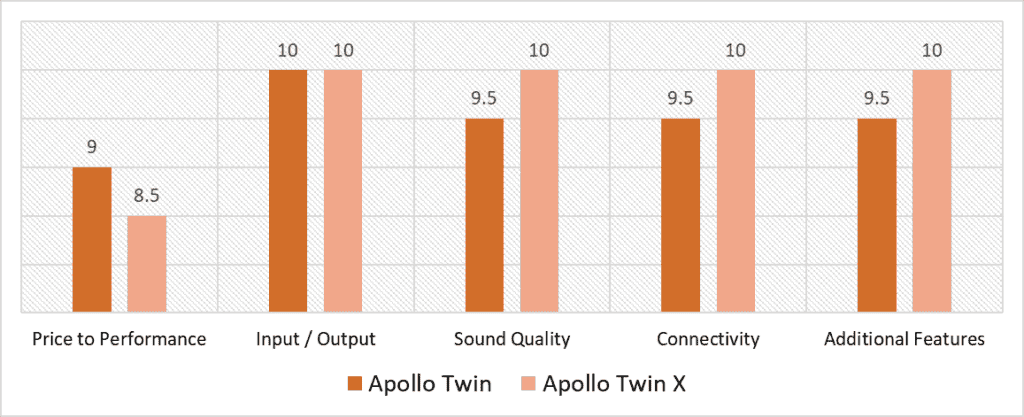As an Amazon Associate ProRec.com earns from qualifying purchases. Any links that take you to products are affiliate links, and we may earn a commission if you make a purchase. We appreciate your support.
All text and image links lead to Amazon unless stated otherwise. All product scores are based on ProRec’s in-house scoring model
Also Read: Apollo Solo vs Apollo Twin
UA Apollo Twin vs. Twin X Features
Apollo Twin | Apollo Twin X | |
|---|---|---|
Connection |
|
|
I/O Design |
|
|
Frequency Response |
|
|
AD/DA |
|
|
Inputs |
|
|
Microphone Dynamic Range |
|
|
Input Gain |
|
|
Digital Audio I/O |
|
|
Outputs |
|
|
Output Dynamic Range |
|
|
Maximum Output Power |
|
|
Hi-Pass Filter |
|
|
DSP Cores |
|
|
Bus Powered |
|
|
Dimensions |
|
|
Weight |
|
|
Box Contents |
|
|
Features |
|
|
UA Apollo Twin vs. UA Apollo Twin X Scoring Model
Price to Performance
If you want the most for your dollar, the Apollo Twin is the superior choice. For one, it has the same I/O as the more expensive Twin X, and even hosts the same features depending on the variant you opt for. The HE Edition MKII is the best choice here since it has the utility of a talkback mic and LUNA recording on Mac. Objectively, if you don’t absolutely need the extra sound quality, the Quad DSP, or a more modern USB-C connection, the base Apollo Twin should be the ideal choice. That said, we give the interface a 9 for its performance.
The Duo DSP Apollo Twin X is the next best value option. For just a bit more, you get better audio quality, and a slightly better USB-C connection. However, the Quad version, while phenomenal for DSP processing, is far too pricey for the same ports and features as the much cheaper Apollo Twin and the Duo Twin X. Averaging it out, we rate the Twin X an 8.5 in Price to Performance.
Input / Output
The Apollo Twin has two XLR/TRS combo inputs, a 1/4″ Hi-Input, two monitor outputs and TRS line outputs each, as well as a stereo headphone jack upfront. However, there is the option of optical expansion with either ADAT or S/PDIF through the Digital I/O port for up to 10 inputs and 6 outputs, which earns it 10 in the category.
The Apollo Twin X has exactly the same number of inputs and outputs as the Apollo Twin, as well as an option for optical expansion. The only difference here is the quality they put out, which doesn’t alter the score in this category. We rate the Twin X a perfect 10 as well.
Sound Quality
The Apollo Twin is an impressive piece of gear. Its audio is clean, and the interface produces a beatiful signal that fits in well with our vocal chain. The interface is plain amazing, we could hear the smallest of EQ moves. The extra clarity really helped get our mixes done faster and cleaner with fewer revisions. Additionally, the integrated DSP helped split the load from our PC. Overall, the interface is a solid 9.5 in Sound Quality.
The difference between the Apollo Twin and the Twin X is immediately apparent. The industry-standard converters make a huge difference, particularly with the upgraded headphone input and increased dynamic range on the preamp. The unison preamps and emulations made arranging our songs much easier. The upgrade in DSP processing gave us a lot more headroom with four cores and allowed for interesting ways to layer our sounds. The interface earns a resounding 10 in the category.
Connectivity
The Apollo Twin comes with the option of either a USB-B connection, or Thunderbolt as a more future-proof alternative. The former is a slight compromise, but it performs similarly nonetheless, so the interface scores a high 9.5 in the category.
The Apollo Twin X has the perfect set of available connections, offering both USB-C and Thunderbolt 3 options that aren’t going away any time soon. This is about as good as it gets, so we rate the interface a perfect 10 in Connectivity.
Additional Features
As far as features go, the Apollo Twin offers a quality set of unison preamps with emulation, a DUO core DSP, monitor controls, a talkback microphone and LUNA on the Twin MKII variant, bundled plugins, as well as additional software on the HE model. The USB model is the least stacked here, but for the options, we rate the interface 9.5/10.
The most consequential difference between the Apollo Twin and Twin X is that the latter comes with both Duo and Quad core processing with the DSP. Additionally, both versions of the Twin X come with a talkback microphone as opposed to just one variant with the base Twin, however, the Quad option is only for the Thunderbolt version. There isn’t much difference other than plugins, even on the HE edition, so we rate the interface a solid 10.
Verdict

Based on our scoring model, the better audio interface is the UA Apollo Twin X with a slim margin of 0.2 points, resulting in a total average score of 9.7. The interface is not only super fast and easy to navigate, but also offers crystal clear audio for instruments and vocals.
All text and image links lead to Amazon unless stated otherwise. All product scores are based on ProRec’s in-house scoring model
The interface also has some great add-ons for solidifying your mix, all in a small package. The UA plugins are a tad expensive here, but they sound great and really help with latency. While the difference is subtle, between the Twin and the Twin X, you’ll want to pick the latter for the best possible sound.
The UAD ecosystem can be a bit jarring for its dependence on DSP chips, but our mixes, arrangements, and songs were better for it, particularly with the Quad core model. One downside with the interface is that you don’t get much else with its higher price, even on the cheaper Duo model. You get the same I/O, monitoring controls, and the same build quality with smooth buttons in the hard steel casing. However, we appreciate the slight upgrade on the USB-C variant of the Twin X, which is overall better than the USB-B connection on the Twin.
The Apollo Twin X has a lot to offer, despite the daunting software console, especially with LUNA on the Thunderbolt variant. Granted, the interface isn’t the cheapest deal, but compared to other similarly priced interfaces, you’d be hard-pressed to find an interface with this level of preamp and converter quality. If you don’t mind the learning curve, UA’s Apollo Twin X will satisfy even the most discerning ear!


